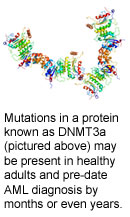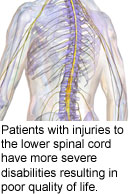Mapping the Earliest Steps of Leukaemia

February 2014 | mcewencentre.com
 Although a number of genetic mutations have been implicated in acute myeloid leukaemia (AML), the path, or series of molecular events, that connects early mutations to the development of leukaemic cells have not been fully defined. Moreover, it is still unclear what impact these early mutations have on AML or if a pre-leukaemic stage of the disease exists. McEwen Centre Researcher Dr. John Dick and his team including lead authors Liran Shlush and Sasan Zandi have provided provocative answers to these questions through detailed analyses of defined blood cell populations from AML patients bearing DNMT3a mutations.
Although a number of genetic mutations have been implicated in acute myeloid leukaemia (AML), the path, or series of molecular events, that connects early mutations to the development of leukaemic cells have not been fully defined. Moreover, it is still unclear what impact these early mutations have on AML or if a pre-leukaemic stage of the disease exists. McEwen Centre Researcher Dr. John Dick and his team including lead authors Liran Shlush and Sasan Zandi have provided provocative answers to these questions through detailed analyses of defined blood cell populations from AML patients bearing DNMT3a mutations.
Using a comprehensive purification scheme developed in his lab, Dr. Dick and his team isolated highly purified stem, progenitor and mature cell populations from patient blood samples. Analysis of these cell populations indicated that the leukaemic blasts from these AML patients predominantly carry DNMT3a and NPMIc mutations, while multipotent non-leukaemic stem and progenitor cell populations predominantly had only DNMT3a mutations suggesting that they might be ancestors of the leukaemic blasts.
Interestingly, the researchers found that non-leukaemic stem cells bearing DNMT3a mutations could differentiate normally and had a growth advantage over non-mutated stem cells. These cells also survived chemotherapy as they were present in samples from patients that were in remission. Thus they form a reservoir from which the leukaemic process starts anew leading to an eventual relapse.
These findings provide a new paradigm in our understanding of early AML development: they serve as a call for the development of early detection and treatment approaches that target mutated pre-leukaemic stem cells, and may provide new ways to monitor disease status in patients in remission.
This research was supported by the Canadian Institutes of Health Research, the Canadian Cancer Society, the Terry Fox Foundation, Genome Canada through the Ontario Genomics Institute, the Ontario Institute for Cancer Research and the Ontario Ministry of Health and Long-Term Care. J Dick holds a Tier 1 Canada Research Chair in Stem Cell Biology.
Identification of pre-leukaemic haematopoietic stem cells in acute leukaemia. Shlush L, Zandi S, Mitchell A, Chen WC, Brandwein JM, Gupta V, Kennedy J, Schimmer A, Schuch AC, Yee KW, McLeod J, Doedens M, Medeiros J, Marke R, Kim HJ, Lee K, McPherson JD, Hudson TJ, The HALT Pan-Leukemia Gene Panel Consortium, Brow AMK, Trinh QM, Stein LD, Minden MD, Wang JCY, Dick JE. Nature. 2014 Jan 11. [Abstract]
 Human embryonic stem cells hold great promise as cellular sources for cardiac repair because they are capable of developing into functioning cardiomyocytes. However, injecting dissociated cardiomyocytes into an injured myocardium significantly decreases their functionality and induces anoikis, which is a form of programmed cell death that occurs when cells are detached from the surrounding extracellular matrix. In addition, injected cardiomyocytes may fail to synchronize with the host heart because they are in a pre-mature state.
Human embryonic stem cells hold great promise as cellular sources for cardiac repair because they are capable of developing into functioning cardiomyocytes. However, injecting dissociated cardiomyocytes into an injured myocardium significantly decreases their functionality and induces anoikis, which is a form of programmed cell death that occurs when cells are detached from the surrounding extracellular matrix. In addition, injected cardiomyocytes may fail to synchronize with the host heart because they are in a pre-mature state.
Researchers at the McEwen Centre have been working on a solution to tackle this problem by growing therapeutic human embryonic stem cell-derived cardiomyocytes (hESC-CMs) in mini-tissues that can facilitate cardiac repair. A new study led by Dr. Ren-Ke Li, which uses this approach to grow cardiac tissues in the lab, has created a stretching device to train the engineered tissue to beat synchronously.
Using this system, the research team has found that stretching the mini-tissues prior to transplantation promotes the maturation of the hESC-CMs and increases the ability of the tissues to conduct electromechanical signals. hESC-CMs that were subjected to stretch were also able to survive longer following transplantation suggesting that this strategy may be a more optimal method of delivering therapeutic cardiomyocytes to injured hearts.
This work was supported by the Canadian Institutes of Health Research. R-K Li holds a Tier 1 Canada Research Chair in Cardiac Regeneration and G Keller holds a Tier 1 Canada Research Chair in Embryonic Stem Cell Biology.
The effect of cyclic stretch on maturation and 3D tissue formation of human embryonic stem cell-derived cardiomyocytes. Mihic A, Li J, Miyagi Y, Gagliardi M, Li SH, Zu J, Weisel RD, Keller G, Li RK. Biomaterials. 2014 Jan 12. [Abstract]
 Stem cells have shown some promise in treating spinal cord injuries (SCIs) due to their ability to repair neural tissues; however, effective stem cell-based therapies for SCI have yet to be developed. This is because SCIs often result in a significant loss of neural tissue accompanied by the formation of cavities and scars that create an environment that prevents neural tissue repair.
Stem cells have shown some promise in treating spinal cord injuries (SCIs) due to their ability to repair neural tissues; however, effective stem cell-based therapies for SCI have yet to be developed. This is because SCIs often result in a significant loss of neural tissue accompanied by the formation of cavities and scars that create an environment that prevents neural tissue repair.
New research from Dr. Michael Fehlings has been exploring ways to enhance the therapeutic efficacy of stem cells by using three-dimensional structures known as nanofibers. When injected into the site of injury, the fibers are able to reduce the amount of inflammation at the site of SCI and preserve the neurons. Moreover, treatment with nanofibers and stem cells is more effective at promoting recovery from SCI than using stem cells alone.
These results demonstrate that using nanofibers may significantly improve the ability of stem cells to promote spinal cord repair and forms a basis for further research on using this strategy for treating SCI.
This work was supported by the Canadian Institutes of Health Research, the Krembil Family Foundation, the Gerald and Tootsie Halbert Chair in Neural Repair and Regeneration, and Phillip and Peggy DeZwirek.
Synergistic effects of self-assembling peptide and neural stem/progenitor cells to promote tissue repair and forelimb functional recovery in cervical spinal cord injury. Iwasaki M, Wilcox JT, Nishimura Y, Zweckberger K, Suzuki H, Wang J, Liu Y, Karadimas SK, Fehlings MG. Biomaterials. 2014 Jan 7. [Abstract]
The International Society for Stem Cell Research recently presented the McEwen Award for Innovation to Dr. Azim Surani (Wellcome Trust/Cancer Research UK Gurdon Institute) in recognition of his research on the role of epigenetics in mammalian development. Dr. Surani is the fourth researcher to win the McEwen Innovation Award, which was established with funding from the McEwen Centre for Regenerative Medicine to support ground breaking research in stem cell biology and regenerative medicine.
 The New York Stem Cell Foundation is accepting applications from early career investigators based at accredited academic and non-profit research institutions throughout the world.
The New York Stem Cell Foundation is accepting applications from early career investigators based at accredited academic and non-profit research institutions throughout the world.
The awards will provide $1.5M in funds to support research that explores the basic biology and translational potential of stem cells. For more information on eligibility or how to apply, click here.
|
Upcoming Events
OSCI Translation Talks
Speaker: Dr. David Hess
Recent Publications
A panel of CpG methylation sites distinguishes human embryonic stem cells and induced pluripotent stem cells. Huang K, Shen Y, Xue Z, Bibikova M, April C, Liu Z, Cheng L, Nagy A, Pellegrini M, Fan JB, Fan G. Stem Cell Reports. 2013 Dec 26. [Abstract] Riluzole improves outcome following ischemia-reperfusion injury to the spinal cord by preventing delayed paraplegia. Wu Y, Satkunendrarajah K, Fehlings MG. Neuroscience. 2014 Feb 6. [Abstract] Thoracic aortic endografting facilitates the resection of tumors infiltrating the aorta. Collaud S, Waddell TK, Yasufuku K, Oreopoulos G, Rampersaud R, Rubin B, Roche-Nagle G, Keshavjee S, de Perrot M. J Thorac Cardiovasc Surg. 2014 Jan 2. [Abstract] Calcium efflux activity of plasma membrane Ca2+ ATPase-4 (PMCA4) mediates cell cycle progression in vascular smooth muscle cells. Afroze T, Yang G, Khoshbin A, Tanwir M, Tabish T, Momen A, Husain M. J Biol Chem. 2014 Jan 21. [Abstract] Identification of pre-leukaemic haematopoietic stem cells in acute leukaemia. Shlush L, Zandi S, Mitchell A, Chen WC, Brandwein JM, Gupta V, Kennedy JA, Schimmer AD, Schuch AC, Yee KW, McLeod JL, Doedens M, Medeiros JJF, Marke R, Kim HJ, Lee K, McPherson JD, Hudson TJ, The HALT Pan-Leukemia Gene Panel Consortium, Brown AMK, Trinh QM, Stein LD, Minden MD, Wang JCY, Dick JE. Nature. 2014 Feb 11. [Abstract] The effect of cyclic stretch on maturation and 3D tissue formation of human embryonic stem cell-derived cardiomyocytes. Mihic A, Li J, Miyagi Y, Gagliardi M, Li SH, Zu J, Weisel RD, Keller G, Li RK. Biomaterials. 2014 Jan 12. [Abstract]
|
The McEwen Centre for Regenerative Medicine, led by director Dr. Gordon Keller, includes 15 scientists at the University of Toronto and five Toronto hospitals, working to advance the development of more effective treatments for conditions including heart disease, diabetes, respiratory disease and spinal cord injury.
The Centre is located at University Health Network, MaRS Centre, Toronto Medical Discovery Tower, 101 College Street, 8th Floor, Room 701, Toronto, Ontario, Canada M5G 1L7
Email: mcewencentre@uhn.ca
Feedback/To Unsubscribe
McEwen Monthly is brought to you by the McEwen Centre for Regenerative Medicine and UHN Research Communications. We hope you have enjoyed receiving this message. If you have any feedback, or if you would prefer to receive the newsletter in text format, please email mkinyanj@uhnresearch.ca.
Images courtesy of Wikimedia commons and stock.xchng.